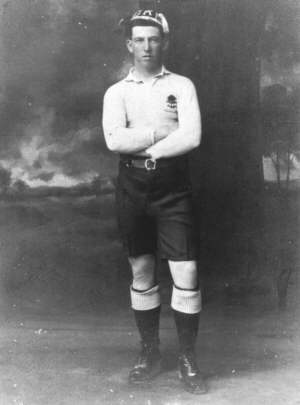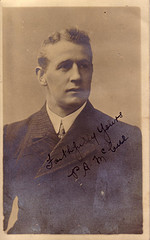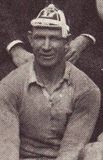
Wally Prigg (1908–1980) was an Australian rugby league footballer. He was a lock for the Australian national rugby league team. He played nineteen Tests for the Kangaroos between 1929 and 1938, seven as captain and was the first Australian player to make three tours to Great Britain with the Australian national rugby league team. He has been named amongst the nation's finest footballers of the 20th century.

Frank Burge was one of the greatest forwards in the history of rugby league in Australia. Later Burge became one of the game's finest coaches. His club career was with Glebe and the St. George Dragons. He represented New South Wales on twenty-six occasions and played thirteen test matches for the Kangaroos and played for Australia in a further twenty-three tour matches.

Arthur 'Pony' Halloway (1885–1961), was a pioneering Australian rugby league footballer and coach. Born in Sydney, New South Wales he played for the Glebe Dirty Reds (1908), Balmain Tigers and Eastern Suburbs (1912–1914), in the New South Wales Rugby Football League premiership. He played for New South Wales in the first rugby match run by the newly created 'New South Wales Rugby Football League' which had just split away from the established New South Wales Rugby Football Union.
Kenneth Howard "Killer" Kearney was an Australian rugby footballer – a dual-code international player – and a rugby league coach. He represented the Wallabies in seven Tests, and the Kangaroos in thirty-one Test matches and World Cup games. He captained Australia in nine rugby league Test matches in 1956 and 1957. He was a hooker and captain-coach with the St. George Dragons in the first half of their eleven-year consecutive premiership winning run from 1956 to 1966. He is considered one of Australia's finest footballers of the 20th century.

Arthur James Summons was an Australian representative rugby union and rugby league player, a dual-code rugby international fly-half or five-eighth. He captained the Australian national rugby league team in five undefeated test matches from 1962 until 1964 and later also coached the side.
Alexander Burdon was an Australian rugby union and pioneer professional rugby league footballer - a dual-code rugby international.

Herbert R. Gilbert was an Australian rugby league and rugby union player – a dual-code international. He represented the Wallabies in three Tests in 1910 and the Kangaroos in seven Tests from 1911 to 1920, his last two as captain. The captain-coach of the St. George Dragons club in Sydney in their inaugural season, he is considered one of Australia's finest footballers of the 20th century. His sons, Herb Gilbert, Jr and Jack Gilbert were also notable rugby league footballers.

John Beaton was an Australian rugby league player, a national representative of the 1930s whose short but brilliant club career was played with Sydney's Eastern Suburbs club. He has been named amongst the nation's finest footballers of the 20th century.

Jack 'Darb' Hickey was an Australian rugby union and pioneer professional rugby league footballer and represented his country at both sports. He was one of Australia's early dual-code rugby internationals. He competed in the 1908 Summer Olympics in rugby union and was notable for scoring the first ever try for the Australian national side in a rugby league test match.

Charles "Boxer" Joseph Russell was a pioneer Australian rugby union and rugby league footballer and coach. He represented his country in both sports and was one Australia's early dual-code rugby internationals. He was a gold medallist at the 1908 Summer Olympics.

John Thomas "Towser" Barnett was a pioneer Australian rugby union and rugby league footballer who won an Olympic gold medal for rugby at the 1908 Summer Olympics. He was one of Australia's early dual-code rugby internationals.

Robert Robertson Craig was an Australian rugby union and pioneer professional rugby league footballer who represented his country at both sports - a dual-code rugby international. He was a member of the Australian rugby union team, which won the gold medal at the 1908 Summer Olympics. Prior to his rugby career he won state championships in swimming and soccer and played top-level water polo.

Robert Stuart (1887–1959) was an Australian rugby union and rugby league footballer and represented his country at both sports - a dual-code rugby international.
Robert Henderson Graves was a pioneer Australian rugby league and rugby union player and one of his country's first dual-code internationals. He was a versatile forward for the Australia national team. He played in 6 Tests between 1908 and 1909, as captain on 1 occasion. In 1907 he played for New South Wales in the first rugby match run by the newly created 'New South Wales Rugby Football League' which had just split away from the established New South Wales Rugby Football Union.

Patrick Aloysius McCue was an Australian representative rugby union player and pioneer rugby league footballer. He was a dual-code rugby international and an Olympic gold medallist.

Charles Herbert "Jeff" McMurtrie was a pioneer Australian rugby union and rugby league footballer who represented his country at both sports. He competed in rugby union at the 1908 Summer Olympics and was an early dual-code rugby international.

Peter Harold Boyne Burge was an Australian rugby footballer and coach. He represented his country in both rugby league and rugby union. The eldest of the four Burge brothers, Peter was one of the first Australian dual-code rugby internationals.

Frederick Wood was an Australian rugby union player, a state and national representative half-back. He was vice-captain of the Wallabies on their first overseas tour in 1908–09 and later captained the side in Test matches in 1910 and 1914. His representative career lasted from 1905 to 1914.

The 1911–12 Kangaroo tour of Great Britain was the second ever Kangaroo tour and was actually a tour by an "Australasian" squad that included four New Zealand players in addition to 24 Australian representatives. It took place over the British winter of 1911–12 and this time, to help promote the game of Rugby league in New Zealand, the Northern Rugby Football Union invited a combined Australian and New Zealand team. They became the first tourists to win the Ashes. and the last to do so on British soil for over half a century. The tour was a success in performance and organisation. Matches were well attended, the squad's touring payments were maintained throughout and the players all shared in a bonus at the tour's end.
Albert Richard Conlon (1880-1956) was an Australian pioneer rugby league footballer from the 1900s.



















